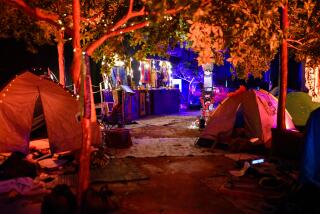Wall Street’s Bulls and Bears Hook Tourists
- Share via
NEW YORK — Recent stock-price volatility might be making some people leery of investing, but it’s not hurting the tour business at the New York Stock Exchange. A record number of tourists are lining up to see what’s going on with their money.
“It is so cool how any ordinary person can own a piece of a company,” said Deepu Murthy, 16, from Los Angeles, who wants to make enough money buying and selling stocks to purchase court-side season tickets to the L.A. Lakers.
*
In September, Murthy and his parents joined a growing number of spectators in a block-long line for free tickets to tour the exchange at the corner of Wall and Broad streets. More than 700,000 people come each year (nearly twice the number that tour the United Nations) to see an arena whose arcane frenzy is becoming ever more important in the lives of Main Street America.
More than half are foreigners, who see the exchange as an integral part of American culture, more important to their future than other New York City landmarks, which commemorate the past.
Conspicuously absent from the thoroughly upbeat tour is any mention of historic market crashes or the fact that markets can go down as well as up. And despite the dramatic swings in the market in October--both up and down--many visitors were optimistic.
“We’ve just begun to buy and sell stocks,” said Nancy Lange, 64, a retired teacher from Rockland County, N.Y. “As long as you’re in it for the long term, the stock market is a lot of fun. I am not sure, though, if I had $200,000 in it, I would find it going up and down so much fun.”
Before last month’s wild swings, Wall Street was riding the biggest bull market in postwar history. And with 41% of Americans now owning stock, either directly or through retirement plans, a pilgrimage to the Big Board has become a way to pay homage to one’s own money--and to dreams that there may soon be a lot more of it.
“When I was growing up, the middle class wasn’t investing as they are today. There was no middle-class investor. We didn’t have 401(k)s,” said William Chilcutt, 52, a registered nurse from Tampa, referring to the tax-sheltered investments that are quickly outpacing traditional pension plans. “Now, I have stocks and I’d like to see how the exchange works so when I see it on TV, I will know what all these guys in funny jackets are doing.”
The NYSE, pleased by its increasing popularity, has spent $2 million to revamp the tour and turn it into a 7,000-square-foot Center for Interactive Education. The effort has been so successful that the exchange is forced to limit tourists to 3,000 a day.
Like everything else on Wall Street, there is a healthy self-interest in the exchange’s investment in tourism.
“If people understand the market, there is a greater possibility of them wanting to invest,” said Brenda Payton, center director. After hours in line down on Wall Street, visitors are herded into the building and move single file through a metal detector while their bags are X-rayed. Visitors then wait in another long line for an elevator to the 12th floor, where the tour begins in a large white room bordered by its own NYSE ticker.
Visitors are greeted by eight giant TV screens tuned to the various national and international networks that broadcast live from the exchange. The tour is self-guided, and includes multimedia displays demonstrating, in seven languages, how the market works.
But many tourists seem neither to understand nor care about the trading complexities of the exchange. They seem content just to be inside a high church of capitalism.
“The more money I get into it, the more I get interested. But I still don’t know how it works,” said Ernest Corder, 28, of Austin, Texas.
*
Out on the street, a thin, metal barricade separates the tourist hordes, most of them clad in T-shirts and shorts and lugging cameras, from the dressed-for-success men and women who are striding in and out of the exchange building.
Inside, tourists stare down at the trading floor from a glass-encased gallery. Many seem mesmerized by a marketplace that is home to 176 billion shares of stock with a current value of more than $8 trillion. Few seem to have a clear notion of what they are watching.
“I know that they (the trader’s jacket) are color-coded, but I don’t know who is who and what they are supposed to be doing,” said Corder’s wife, Kimberly.
The floor is crowded with 2,800 people--traders, specialists, clerks and operating personnel--all of whom seem to be rushing around doing something important. Under the exchange’s continuous auction system, buyers and sellers on the floor talk continuously, as all buyers must buy through a dealer and all sellers must sell to a dealer. Customers do not trade with one another.
(BEGIN TEXT OF INFOBOX / INFOGRAPHIC)
GUIDEBOOK
Wall Street Waltz
Getting there: The New York Stock Exchange is located at 20 Broad St., at Wall and Broad streets in lower Manhattan.
Hours: 9 a.m. to 4:30 p.m. Monday through Friday, except for holidays. Admission is free, but you must get a ticket at the admissions counter outside the exchange. Reservations are required for groups of 10 or more (maximum: 25 people).
For more information: Call (212) 656-5165 for reservations or more information. The Web site address is https://www.nyse.com.


